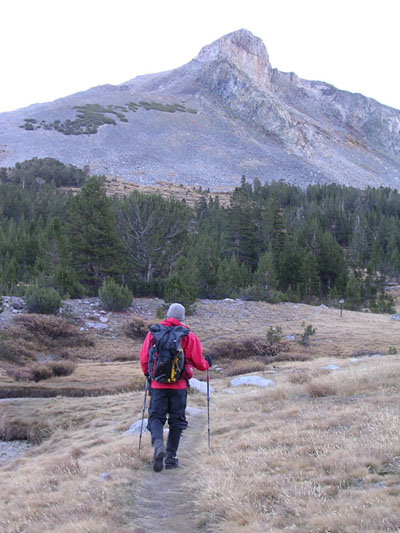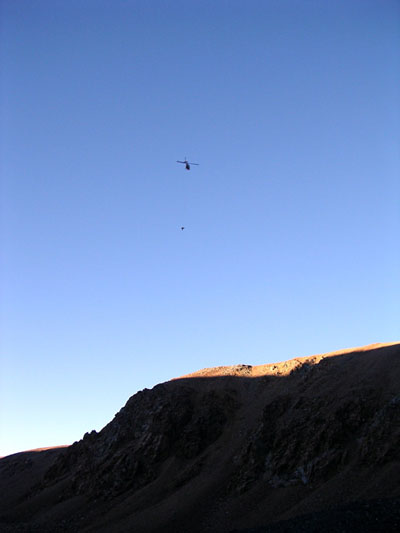
| Peak: Mt. Dana Elevation: 13,057 feet Route: Dana Couloir Rating: Class 4, 40-degree snow and ice Elevation Gain: 3,400 feet Range: Sierra Nevada Location: Ansel Adams Wilderness, Inyo National Forest, California Date: October, 2004 Entry/Exit Point: Tioga Lake Approach: Glacier Canyon Trail (about 4 miles) Guide Book: John Moynier and Claude Fiddler, “Climbing California's High Sierra,” The Globe Pequot Press, Connecticut, 2002. |
Account written for American Alpine Club's "Accidents in North American Mountaineering."
On October 12, my wife and I, attempted a one-day ascent of Mt. Dana via Dana Couloir, a popular 1,000-foot ice climb rated Class 4 ice/snow. Dana Couloir lies within Ansel Adams Wilderness in the Sierra Nevada range and is neighbor to Yosemite National Park across the peak. Ann and I have been climbing partners for six years and had previously attempted Mt. Dana in June 2002, when we were turned back by high winds at the top of the couloir.
We set off at around 7am and reached Dana Glacier about three hours later. The weather was pleasantly calm, with clear skies and light winds. The only other group on the mountain was a couple of climbers sorting gear at the base of the glacier.
The glacier was free of snow, typical for this time of the year, and consisted of hard, lumpy ice and, in some places, hard water ice. The bergschrund, about one rope length above, was open. Further up, I could see the couloir gleaming with ice. We had planned to simul-climb the length of the couloir, scramble to the summit and descend on the trail leading down to Tioga Pass.
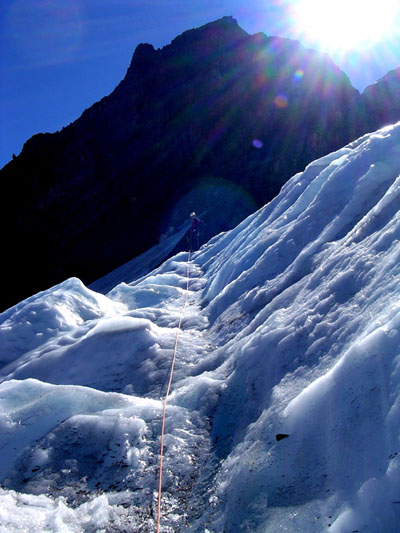 I racked the gear (including ice screws and quickdraws) and started a rising traverse towards the right side of the bergshrund. After most of the slack was out, Ann followed behind me. The glacier starts at a comfortable walking angle, then steepens to about 40 degrees near the bergschrund.
I racked the gear (including ice screws and quickdraws) and started a rising traverse towards the right side of the bergshrund. After most of the slack was out, Ann followed behind me. The glacier starts at a comfortable walking angle, then steepens to about 40 degrees near the bergschrund.
I remember climbing to within 20 feet of the bergschrund, stopping for a picture and continuing to climb for another minute or so. I did not feel the need to place, and thus had not placed, any protection up to this point. I do not have any memory of the accident…whether it caught me by surprise, whether I tried to arrest the fall, the feeling of acceleration from sliding and tumbling for 200 feet…nothing. My next memory is that of crouching next to Ann, hearing the thumping of an approaching helicopter, and wondering why I was feeling so bad. Thus, Ann takes over the account for the next four hours, until shortly before my rescue.
Ann: While traversing the glacier, I tried to follow Pedro’s path. However, shortly after we paused for a picture, I diverted slightly and came upon a patch of hard water ice. The angle of the glacier was still moderate, so I did not stop to find an alternate route or ask Pedro to place protection. As I took my next step, my foot slipped under me and I started to fall. My crampons did not hold my footing as I thought they would.
I instinctively yelled and tried to self arrest, but I could not dig my ice tool into the hard ice. I was sliding fast, expecting only the boulders at the base of the glacier to end my fall. All of a sudden, I stopped. I took a few seconds to gather my thoughts. As I was lying face down on the ice, I heard raspy, labored breathing emanating from a source nearby. It sounded like a bear, but it was Pedro. He had fallen to the same height as me, about 10 feet to the side. He lay upside down and a streak of blood originating from his face was trickling down the ice.
I had fallen approximately 100 feet and Pedro, who had started higher, close to 200 feet. While I mostly slid down the glacier on my back and sides, Pedro likely tumbled down when he was pulled off the ice by my fall.
I called Pedro several times, but got no response. He was unconscious. I looked up and saw that our rope was caught on an ice outcropping, which had fortuitously stopped our fall. Level ground was still more than 150 feet below, so my first thought was to secure us in case the ice outcropping gave way. Pedro had all the ice screws. He was out of reach, but at this moment he regained consciousness. He tried standing up several times despite my urging him not to. He had lost an ice tool during the fall and was otherwise unable to place a screw, so I asked him to throw one to me. He fumbled for some time to unclip one, but once he did, to my surprise, he threw it to me accurately. I placed it and clipped us in.
I could see that Pedro was disoriented, slow to respond and not fully coordinated. He appeared dazed and kept asking “Why do I feel so bad?” There was blood all over his face and he complained of a persisting, sharp pain in both wrists and the right knee.
Meanwhile, one of the two climbers we had seen earlier, who had witnessed our accident, climbed up to help. Paul, a mountain guide, was on a trip with his client, Kirill, who unwittingly got to experience mountain rescue firsthand. When Paul reached us, he asked Pedro some basic questions to assess his condition and Pedro accurately answered them all. I tried to summon help on the cell phone, but there was no reception. We knew it was necessary to get Pedro off the glacier on our own.
Paul set up an anchor and belayed Kirill up. Pedro was in no condition to down climb or even to rappel himself, so Paul lowered him with Kirill, who supported him. Progress was slow as Pedro was reluctant to lean back on the rope. When the rope was almost out, Kirill set up an anchor and secured himself and Pedro. I then rappelled down and Paul down climbed. We repeated the process once more until we reached a relatively flat area. We tried walking down the rest of the glacier with Kirill and Paul supporting Pedro, but in his dazed state, Pedro was hard to manage. So, we decided to stop there.
 Our first priority was to keep Pedro warm to prevent him from going into shock. Paul generously offered his ensolite pad, emergency blanket and down vest, then he hiked out to seek help. It was about noon. While we waited, Kirill made miso soup, but Pedro would only have warm water. He was still dazed and in pain and was beginning to shiver, as we were in the shade by now. I tried to keep him warm and awake and also bandaged his face, which had stopped bleeding. Time passed slowly. Finally, around 3pm, we heard the sound of a helicopter approaching. Pedro was stunned when I told him it was coming for him. He did not want to cause so much trouble. From this point on, Pedro recalls the events and resumes the account.
Our first priority was to keep Pedro warm to prevent him from going into shock. Paul generously offered his ensolite pad, emergency blanket and down vest, then he hiked out to seek help. It was about noon. While we waited, Kirill made miso soup, but Pedro would only have warm water. He was still dazed and in pain and was beginning to shiver, as we were in the shade by now. I tried to keep him warm and awake and also bandaged his face, which had stopped bleeding. Time passed slowly. Finally, around 3pm, we heard the sound of a helicopter approaching. Pedro was stunned when I told him it was coming for him. He did not want to cause so much trouble. From this point on, Pedro recalls the events and resumes the account.
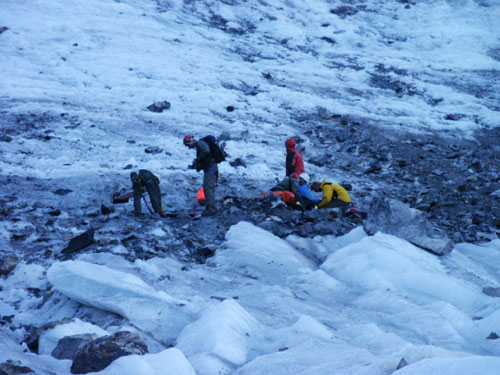 Pedro: The helicopter circled several times around the terminus of the glacier in search of a suitable landing spot and finally landed 100 yards away. A rescue crew of five quickly made their way to us and placed me in a full body splint and rescue litter.
Pedro: The helicopter circled several times around the terminus of the glacier in search of a suitable landing spot and finally landed 100 yards away. A rescue crew of five quickly made their way to us and placed me in a full body splint and rescue litter.
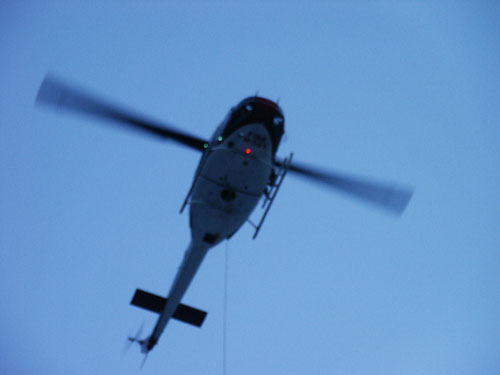 The helicopter hovered overhead, lowered a cable and carried me (along with one rescuer) on a “short haul” to a nearby ridge. I specifically recall how comfortable and warm I felt and the tremendous view of the glacier and surroundings. Once on the ridge, I was moved inside the helicopter and flown to the Tioga Road, where an ambulance was standing by to take me to Mammoth Hospital. Then the helicopter flew back to pick up Ann--who had a sprained ankle--and the rest of the crew. Ann got a ride to the hospital from a member of the Mono County sheriff’s office.
The helicopter hovered overhead, lowered a cable and carried me (along with one rescuer) on a “short haul” to a nearby ridge. I specifically recall how comfortable and warm I felt and the tremendous view of the glacier and surroundings. Once on the ridge, I was moved inside the helicopter and flown to the Tioga Road, where an ambulance was standing by to take me to Mammoth Hospital. Then the helicopter flew back to pick up Ann--who had a sprained ankle--and the rest of the crew. Ann got a ride to the hospital from a member of the Mono County sheriff’s office.
After numerous x-rays and a CAT scan, the doctors at Mammoth Hospital informed me of the injuries: concussion, broken mandible, a badly broken left wrist, hairline fracture of the C5 vertebra, sprained knee, sprained clavicle and several lacerations to the face. The broken wrist turned out to be the worst. The fall had shattered my scaphoid, a notoriously difficult bone to heal, in five pieces, requiring surgery and three pins to put back together. Five months after the accident, I am just beginning to regain motion in the joint. Still, things are progressing, and I hope to be back climbing come springtime.
This is my first accident in nearly ten years of climbing. Although I consider myself a cautious climber, I must admit to having taken this climb for granted. I was focusing on the climb ahead and failed to appreciate the changing terrain. As the leader, I should have protected the climb using a running belay. In addition, I was carrying all the ice protection, leaving Ann ill-equipped to deal with the situation when I became injured. On future climbs, we will each carry appropriate gear.
Having time to reflect on the accident and the injuries I sustained, and more importantly the ones that I did not, I am very glad to have worn a helmet. There is no doubt my injuries would have been much more severe, if not fatal, had I not been wearing one. Although I felt no pain in my neck, I turned out to have a hairline cervical fracture. Use of a cervical collar and backboard is standard procedure to prevent further spinal injury after such a trauma as mine. That gear is hard to come by on a glacier, but the result of improper movement in such a situation can be catastrophic. Whether to stay on the steep, cold ice, immobilized by a partner, or descend to a safer, more comfortable environment is a tough call and a consideration every lay rescuer needs to think through.
Photo by Kirill
